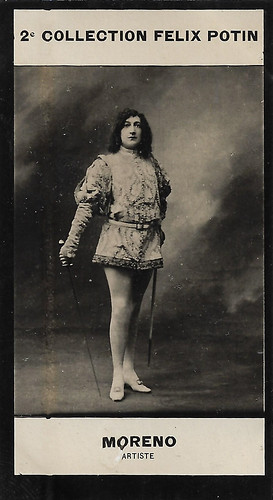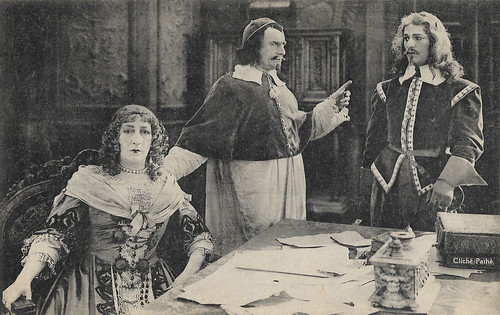
French postcard by Editions Cinémagazine, no. 52. Photo: Pathé Consortium Cinema. Marguerite Moreno as Anne d'Autriche in the Alexandre Dumas adaptation Vingt ans après (Henri Diamant-Berger, 1922).
The muse of the symbolists
Marguerite Moreno was born in Paris in 1871. She was the daughter of Pierre Monceau, a mathematics teacher, and Charlotte Lucie Moreno.
Moreno studied in Paris and Bretagne, then entered the Paris Conservatoire, in the class of Gustave Worms. She was engaged by the Comédie-Française in 1890, and acted on stage with the famous names of the French stage: Charles Le Bargy, Mounet-Sully, Julia Bartet, Coquelin Sr. and Paul Mounet.
She became the 'muse of the Symbolists' and poet Stéphane Mallarmé’s close friend, but nevertheless, she didn’t manage to convince him to stage his 'Hérodiade'. It was Moreno who, in 1898, organised his funeral at he church and graveyard of Samoreau près la Seine, where he had his country house.
She was the mistress of the poet Catulle Mendès. Their son died of meningitis. Moreno married in Britain writer Marcel Schwob in 1900. Unfortunately, Schwob fell ill and died in 1905, at the age of 37. In 1903, Marguerite Moreno left the Comédie-Française and joined the Théâtre de Sarah Bernhardt, and afterwards the Théâtre Antoine.
In 1908, she remarried to actor Jean Daragon. For seven years, she ran the French section of the Conservatory in Buenos Aires. When the First World War broke out, she was active at the military hospital in Nice.

French postcard in the Série Les artistes de la "Comédie-Française" dans leur loge by Raphael Tuck et Fils, Editeurs, Paris, c. 1900. The photos, though, may have been a bit older, like the 1890s.

French postcard, no. 1/11. Photo Paul Boyer, Paris. Marguerite Moreno in 'La Sorcière' at the Theatre Sarah Bernhardt, Paris. Moreno performed in this play by Victorien Sardou in 1903.
Ringed eyes and a rosebud mouth
In 1915, Marguerite Moreno discovered the cinema. In the silent era, she played together with her second husband, Jean Daragon, in Vingt ans après / Twenty Years After (1922) by Henri Diamant-Berger.
Vingt ans après / Twenty Years After (1922) was the sequel to Les Trois Mousquetaires / The Three Musketeers (1921), the first film version of Alexandre Dumas, Père's novel 'The Three Musketeers'. Both films were directed by Diamant-Berger.
Moreno impersonated Queen Anne of Austria “under a plaster-like make-up, with ringed eyes, and a rosebud mouth”, as Olivier Barrot and Raymond Chirat wrote in 'Noir & Blanc: 250 acteurs du cinéma français 1930-1960' (2000). Daragon played Beaufort in Vingt ans après, but it was to be his last film. A year later, in 1923, he died.
Moreno acted in several other films by Diamant-Berger: Paris pendant la guerre (1916), Le Mauvais garçon (1923), opposite Maurice Chevalier in Gonzague (1923), L'Accordeur (1923) and L'Emprise (1924), starring Pierre de Guingand and Pierrette Madd.
In the late 1920s, she also acted in films like Le Capitaine Fracasse (1929) by Alberto Cavalcanti, starring Pierre Blanchar and Lien Deyers.

French collector card (minicard) by Chocolat Félix Potin, Second Series, 1908. Caption: Moreno, artiste.

French postcard by Editions Cinémagazine, no. 60. Photo: Pathé Consortium Cinema. Marguerite Moreno, Jean Périer and Henri Rollan in Vingt ans après / Twenty Years After (Henri Diamant-Berger, 1922).
Countesses, duchesses and queens
When sound cinema arrived in France, Marguerite Moreno had an enormous increase in film roles. In 1930-1932, she played at least one film part each month, a number which slowly went down in the course of the 1930s. On the instigation of her friend and soulmate, the writer Colette, Moreno started playing comedy, and in 1920, she had a big success on stage with 'Le Sexe faible' by Édouard Bourdet. Here she played “an old Slavic countess who hires beautiful boys to pass boredom”, as Maurice Martin du Gard mentioned in his 'Carte rouge' (1930).
Moreno repeated the part in the adaptation filmed by Robert Siodmak in 1933 and starring Victor Boucher. Moreno often played countesses, duchesses and queens, though she included the lower classes as well. In the interbellum years, Moreno installed herself in an estate in the Lot province. It was renovated by her cousin, actor Pierre Moreno, who lived and acted with her and was her lover too.
Moreno spread her career between the stage and the screen, and according to Barrot and Chirat, "she accepted all that was offered her. The average spectator’s laugh at each of her performances was enough for her." She appeared, e.g. in Un trou dans le mur (1930) by René Barberis, Tout va très bien madame la marquise (1936) by Henry Wulschleger, and La Fessée (1937) by Pierre Caron.
However, Moreno was also directed by Raymond Bernard in Les Misérables (1934), where she and Charles Dullin played the evil couple Thenardier opposite Harry Baur as Jean Valjean.
She played aristocrats again in Jean Delannoy's Paris-Deauville (1933) and in La dame de pique (1937) by Fedor Ozep. She did various parts in films by Sacha Guitry: Faisons un rêve, Le Roman d'un tricheur and Le Mot de Cambronne in 1936, Les Perles de la couronne in 1937, Ils étaient neuf célibataires in 1939, and Donne-moi tes yeux in 1943.

French postcard, no. 559. Collection: Didier Hanson.
You cannot be ugly with such an expressive face
Marguerite Moreno worked with several interesting film directors. With Marcel Pagnol, she played in Regain (1937) starring Fernandel, and the uncompleted film La Prière aux étoiles (1941).
With Christian-Jaque, she made Carmen (1942) and Un revenant (1946) with Louis Jouvet, and with Claude Autant-Lara, she acted in Douce (1943).
In 1945, Marguerite Moreno was a giant success on stage as Aurélie in 'La Folle de Chaillot', written for her by Jean Giraudoux. Paul Valéry considered her the only one capable of reciting poems, so he invited her to recite them during his courses at the Collège de France.
Marguerite Moreno died in Touzac (Lot) in 1948. Her last film, L'assassin est à l'écoute (Raoul André, 1948), was released a few weeks after her death. Her house and estate, 'La Source bleue' (The Blue Source) in Touzac, was transformed into an inn by her heirs.
Paul Léautaud wrote on her: “Tonight while listening to Moreno in Aricie, I was crying softly…” and “People say she is ugly, but you cannot be ugly with such an expressive face, and so delicate at the same time – her eyes, her nose, her mouth are so full of wit. Moreover, she has it in such a way as seldom to be found in a woman. She is female malice and satire embodied.” The Marguerite Moreno Papers were purchased by Yale University in 2009.

French postcard by Cinémagazine, no. 69. Photo: Pathé Consortium. Marguerite Moreno as Queen Anne of Austria, widow of King Charles XIII in Vingt ans après/The Return of the Musketeers (Henri Diamant-Berger, 1922).
Sources: Wikipedia (French) and IMDb.
This post was last updated on 30 October 2025.
No comments:
Post a Comment